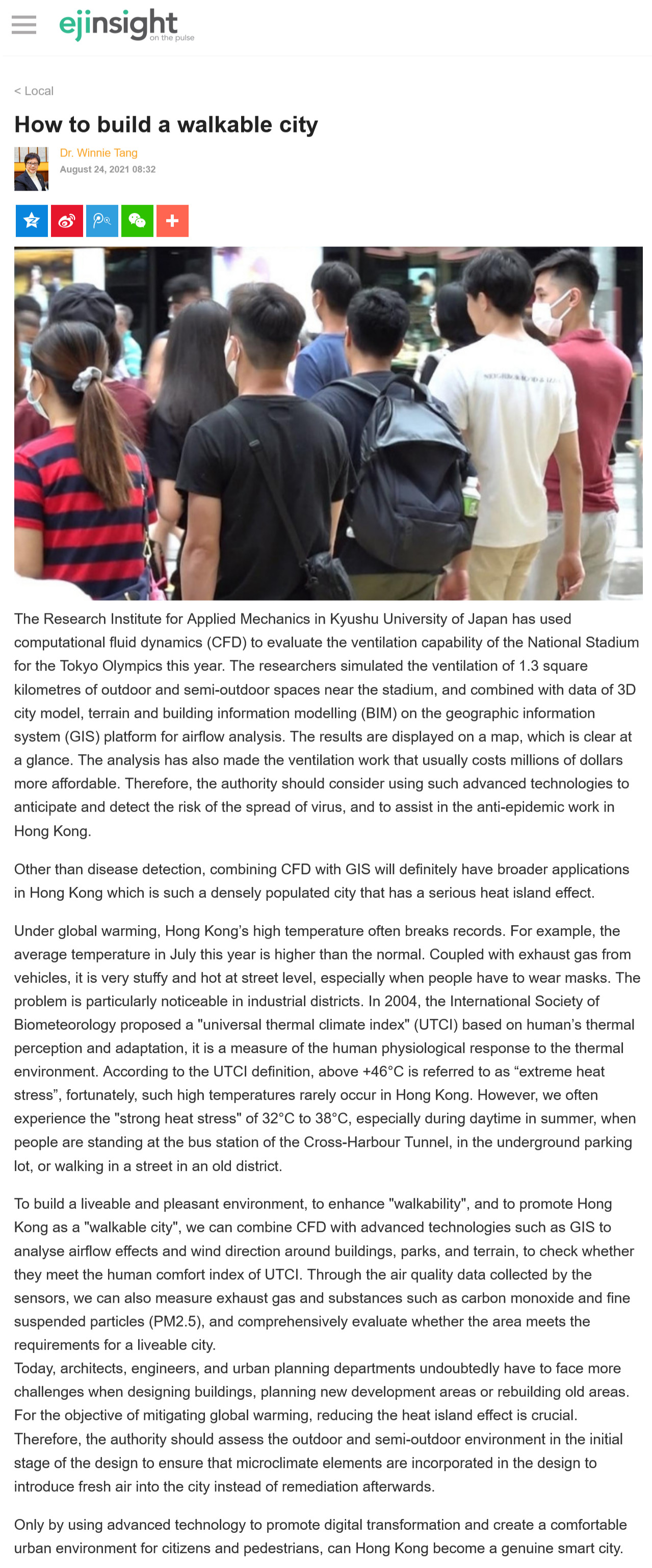網上版請按此

How to build a walkable city
The Research Institute for Applied Mechanics in Kyushu University of Japan has used computational fluid dynamics (CFD) to evaluate the ventilation capability of the National Stadium for the Tokyo Olympics this year. The researchers simulated the ventilation of 1.3 square kilometres of outdoor and semi-outdoor spaces near the stadium, and combined with data of 3D city model, terrain and building information modelling (BIM) on the geographic information system (GIS) platform for airflow analysis. The results are displayed on a map, which is clear at a glance. The analysis has also made the ventilation work that usually costs millions of dollars more affordable. Therefore, the authority should consider using such advanced technologies to anticipate and detect the risk of the spread of virus, and to assist in the anti-epidemic work in Hong Kong.
Other than disease detection, combining CFD with GIS will definitely have broader applications in Hong Kong which is such a densely populated city that has a serious heat island effect.
Under global warming, Hong Kong's high temperature often breaks records. For example, the average temperature in July this year is higher than the normal. Coupled with exhaust gas from vehicles, it is very stuffy and hot at street level, especially when people have to wear masks. The problem is particularly noticeable in industrial districts. In 2004, the International Society of Biometeorology proposed a "universal thermal climate index" (UTCI) based on human's thermal perception and adaptation, it is a measure of the human physiological response to the thermal environment. According to the UTCI definition, above +46°C is referred to as "extreme heat stress", fortunately, such high temperatures rarely occur in Hong Kong. However, we often experience the "strong heat stress" of 32°C to 38°C, especially during daytime in summer, when people are standing at the bus station of the Cross-Harbour Tunnel, in the underground parking lot, or walking in a street in an old district.
To build a liveable and pleasant environment, to enhance "walkability", and to promote Hong Kong as a "walkable city", we can combine CFD with advanced technologies such as GIS to analyse airflow effects and wind direction around buildings, parks, and terrain, to check whether they meet the human comfort index of UTCI. Through the air quality data collected by the sensors, we can also measure exhaust gas and substances such as carbon monoxide and fine suspended particles (PM2.5), and comprehensively evaluate whether the area meets the requirements for a liveable city.
Today, architects, engineers, and urban planning departments undoubtedly have to face more challenges when designing buildings, planning new development areas or rebuilding old areas. For the objective of mitigating global warming, reducing the heat island effect is crucial. Therefore, the authority should assess the outdoor and semi-outdoor environment in the initial stage of the design to ensure that microclimate elements are incorporated in the design to introduce fresh air into the city instead of remediation afterwards.
Only by using advanced technology to promote digital transformation and create a comfortable urban environment for citizens and pedestrians, can Hong Kong become a genuine smart city.
Dr. Winnie Tang
Adjunct Professor, Department of Computer Science, Faculty of Engineering; Department of Geography, Faculty of Social Sciences; and Faculty of Architecture, The University of Hong Kong